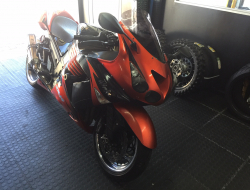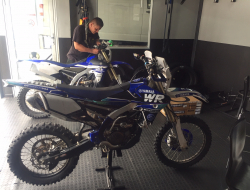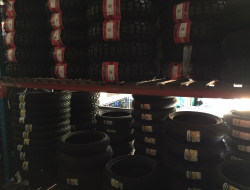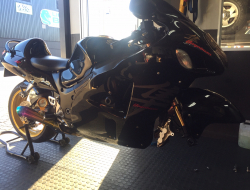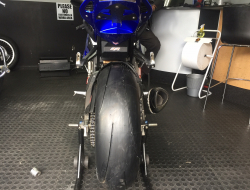MOTORCYCLE TYRES:
LOAD INDEX & SPEED RATINGS
Speed Symbol
The SPEED SYMBOL indicates the maximum speed at which the tyre can carry a load corresponding to its Load Index under service conditions specified by a tyre manufacturer.
These speeds are shown in Table 1 and apply to tyres when in good condition, inflated to the correct pressure, operating within their specific load capacity and fitted to the correct size rim. Speeds quoted are the maximum speed of which the tyre is capable, not the speed at which it is normally ridden. V, W and Z rated tyres may also be used at higher speeds but at reduced loadings. For guidance only Table 3 can be used to calculate loads at specific speeds on V, W and Z tyres.
ALL MAXIMUM SPEEDS REFERRED TO ARE SUBJECT TO APPLICABLE LEGAL SPEEDS.
Load Index
The LOAD INDEX is a numerical code associated with the maximum load a tyre can carry (except for loads at speeds above 130 mph (210 km/h) – see Table 2/2a) at the speed indicated by its Speed Symbol under service conditions specified by manufacturer. You should only fit replacement tyres bearing the precise speed and load index referred to in the motorcycle manufacturer’s handbook. Before you make any variation please consult the manufacturer to ensure that the replacement tyre is a correct fitment for your motorcycle.



WIDTH (190)
This number indicates the tyre’s section nominal width, measured in millimeters from sidewall to sidewall. In this case 190mm. Note: the actual physical width of the tyre on the rim can differ from the nominal width.
ASPECT RATIO (50)
This number indicates the tyre’s aspect ratio or height expressed as a percentage of its width. In this case the aspect ratio is 50% of the 190mm width, making it 95mm.
WHEEL DIAMETER (ZR17 M/C)
On a sports bike tyre these letters are usually “ZR”. The “Z” indicates the speed rating of the tyre, which in this case means it is rated above 240kph/149mph. The “R” denotes that the tyre is of radial type construction. The “17″ denotes that the tyre is 17 inches in diameter whilst “M/C” means the tyre is for a motorcycle.
LOAD INDEX & SPEED RATING (73W)
The ‘73W’ indicates the load and speed indexes of the tyre and should always be looked at together when you buy a new tyre. In this case the ’58’ denotes that the tyre is rated for a maximum carrying weight of 236kg at maximum pressure. The “W” represents the maximum speed for the tyre when it is correctly inflated and being used under load, in this case 270km/h. Please remember however that when buying new tyres that you match the speed rating with the speed capabilities of your motorcycle, if exceeded, this risks tyre failure, hence you should always replace a tyre with one of at least the same speed rating so that you don’t reduce the speed capability of your bike.
Please refer to the load index and speed rating tables for more information.
Tyre Safety Rules
- Observe specified minimum tyre pressures. (See motorcycle owner's manual)
- Check inflation pressure, and adjust if necessary.
- Do not exceed maximum load capacity.
- Avoid impact strain. (E.g. curbstones)
- Check tyres regulary for signs of damage.
- Never ride on tyres with less than 2mm tread depth. (More is better)
- Only buy specified tyres. Handling characteristics can only be optimized through proper tyre fitment.
- Use the right inner-tubes to match the tyres (if necessary). New tubes for new tyres.
- Make sure valve caps are fitted. New valve for new tubeless tyre.
- Only use specified rims in perfect condition. Specialty rims require special approval.
- Only have tyres fitted by a skilled tyre fitter.
TYRE CONVERSION CHART:

TUBES:
Valve Stem Configurations:

MOTORCYCLE CHAINS:
Chain sizes:
The size of the chain can usually be found on the side of a link.

Generally sizes are referred to as 'pitch X length'.
Example: 428X114 - pitch of 428 and chain length of 114 links.
The distance between the chain pins is referred to as the ‘Pitch’.

Chain Types:
Standard Chain: is a regular chain suited for smaller road bikes. (125cc-250cc)
Heavy Duty Chains: popular for mid- sized road bikes & most MX bikes.
O-ring Chain: Suitable for most road bikes over 400cc & also for MX/Enduro use. They retain lube better than HD chains.
Z-ring or X-ring Chains: Both retain grease longer than an O-ring due to the shape of the rubber rings.
Chain Maintenance:
Road bikes: Lubricate chain every 500-800 km’s.
Off-road/motocross bikes: Depending on riding conditions, however lubrication recommended after each ride and after each high pressure clean. Allow chain lube sufficient time to dry before riding again.
Chain Replacement:
The motorcycle chain's appearance will be a good indicator of when to change your bike chain. If it's stretched or twisted, it's time to change your bike chain. You should also take a close look at the chain links, making sure that they're not worn. If they are, change them.
Always replace the chain and both sprockets at the same time. A worn component will shorten the life of the rest.

